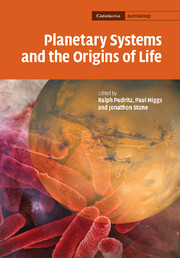Book contents
- Frontmatter
- Contents
- List of contributors
- Preface
- Part I Planetary systems and the origins of life
- Part II Life on Earth
- 6 Extremophiles: defining the envelope for the search for life in the universe
- 7 Hyperthermophilic life on Earth – and on Mars?
- 8 Phylogenomics: how far back in the past can we go?
- 9 Horizontal gene transfer, gene histories, and the root of the tree of life
- 10 Evolutionary innovation versus ecological incumbency
- 11 Gradual origin for the metazoans
- Part III Life in the Solar System?
- Index
8 - Phylogenomics: how far back in the past can we go?
Published online by Cambridge University Press: 13 August 2009
- Frontmatter
- Contents
- List of contributors
- Preface
- Part I Planetary systems and the origins of life
- Part II Life on Earth
- 6 Extremophiles: defining the envelope for the search for life in the universe
- 7 Hyperthermophilic life on Earth – and on Mars?
- 8 Phylogenomics: how far back in the past can we go?
- 9 Horizontal gene transfer, gene histories, and the root of the tree of life
- 10 Evolutionary innovation versus ecological incumbency
- 11 Gradual origin for the metazoans
- Part III Life in the Solar System?
- Index
Summary
Introduction
The remnants of ancient life on Earth are extremely rare and difficult to interpret, since they have been modified by billions of years of subsequent geological history. Therefore, any understanding of the evolution of Earth's biosphere will heavily rely on the study of extant organisms for which complete genome sequences are already available or will eventually be established. A central point is the phylogenetic inference of the tree of life from such genomic data. Serving as a unifying framework, this tree will allow the disparate and often incomplete pieces of information gathered by various disciplines to be collected and structured. In the first half of this chapter, we will briefly explain the principles of phylogenetic inference and the major artefacts affecting phylogenetic reconstruction. Then we will introduce phylogenomics, starting with a theoretical presentation before illustrating the explained concepts through a case study centred on animal evolution. In the second half, we will review our present understanding of eukaryotic evolution and show how recent knowledge suggests that secondary simplification is an important mode of evolution that has been too long overlooked. We will also summarize the current views about the root and the shape of the tree of life. Finally, we will attempt to debunk two common hypotheses about the early evolution of life, i.e., a cell fusion at the origin of eukaryotes and a hyperthermophilic origin of life.
- Type
- Chapter
- Information
- Planetary Systems and the Origins of Life , pp. 149 - 177Publisher: Cambridge University PressPrint publication year: 2007



